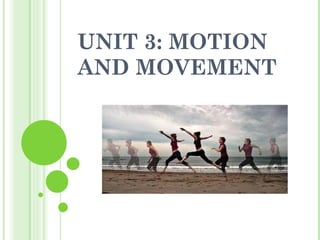
Unit 3: Motion and movement
- 1. UNIT 3: MOTION AND MOVEMENT
- 2. WHAT IS THE MOVEMENT? Movement is the change of position of an object in relation to a fixed point in space. In physics, motion is the change of location or position of an object with respect to time.
- 3. MOTION CHARACTERISTICS The main characteristics are the following ones: position, trajectory, distance travelled, displacement, time taken, speed and acceleration. Position is precisely where an object is located. Trajectory is the path that a moving object follows through space. It can be rectilinear, circular, parabolic etc . Ex: a ball thrown into a basket is parabolic or the hands of a watch is circular.
- 4. The distance travelled is the length of the trajectory made by the moving object from the initial position to the final position. The displacement (D) is the distance, measured in straight line, between the initial position(Xi) and the final position (Xf). D=Xf-Xi
- 5. Speed is the distance travelled per unit of time. Average speed (Vm) is calculated dividing the distance travelled by the time spent. Vm= distance travelled time spent The unit used to measure the speed in the SI is metres per second. (m/s)
- 6. UNIFORM LINEAR MOTION A body has a uniform linear motion if the trajectory is a straight line and the speed is constant. d= v x t time Distance Distance-time graph travelled speed Speed-time graph
- 7. ACCELERATION If speed changes in a movement, it is an accelerated motion. Acceleration is how fast the speed of an object is changing. It is calculated dividing the variation of speed by the time spent at this variation. vfinal - vinitial a tfinal - tinitial The unit used in the SI is metres per square second (m/s2)
- 8. UNIFORMLY VARIED MOTION The speed varies in a uniform way. Ex: A train starting off o stopping.
- 9. Motion can be what can change the speed of objects or can deform them, are the Uniform motion Change of position with respect to another one that we consider as fixed. Speed doesn’t change Trajectory Position Distance travelled Speed Acceleration can be The acceleration is It is equal to the defined as the ratio subtraction between between what the Accelerated motion two positions speed has changed Rectilinear and the time Circular It is the ratio between elapsed to occur Parabolic It is where the distance travelled that change Elliptical an object and the time elapsed Speed changes Hyperbolic is located to do it Forces
- 10. ACTIVITY 1 An athlete can run long distances at 4 metres per second. How far can she run in? c)50 seconds e)3 minutes g)1 hour i)2 hours and a half
- 11. ACTIVITY 2 Andrew rows at an average speed of 2 metres per second. a)How long does it take him to row: Speed Distance • 70 m Time • 800 m Distance Speed x Tim e • 1 km and a half Time Distance b) How far can Andrew row in: Speed • 12 seconds • 3 minutes and a half • 4 hours
- 12. ACTIVITY 3 A snail moves 5 m in 2 hours. If it moves at the same speed all the time, calculate: a)The time it takes to move 20 m c) The distance it would move in 3 hours and a half e)The time it takes to move 1 m g)The distance it moves in 15 minutes
- 13. ACTIVITY 4 John can type 960 words in 20 minutes. Calculate his typing speed in: c)Words per minute d)Words per hour
- 14. ACTIVITY 5 A car is at rest and accelerates with an acceleration of 5 m/s2 during 10 seconds, we can say that: A. It has an average speed of 50 m/s. C. It travels a distance of 50 m. E. Its final speed is 50 m/s. G. It travels a distance of 2 m.
- 15. ACTIVITY 6 The graph represents data of positions and times of the movement of an object. A. Is it an uniform motion or an accelerated motion? Justify your answer. s (m) B. The position of the object at 2 seconds from when the movement started. The position of the object at 6 seconds. C. Speed at the interval 2-6 seconds. D. The position of the object at 4 seconds from when the movement started. The position of the object at 10 seconds. E. Speed at the interval 4-10 t (s) seconds. F. How has the trajectory been?
- 16. ACTIVITY 7 Given the following values tables, answer the following questions. Values table A Values table B s (m) t (s) s (m) t (s) A. Draw the graph s/t of each 2 0 0 0 movement. 4,5 1 2 1 C. Calculate the average speed in 7 2 5 2 the first five seconds for each 9,5 3 9 3 values table. 12 4 14 4 14,5 5 20 5 E. Calculate the average speed in 17 6 27 6 the time elapsed from the second five to the second ten 19,5 7 35 7 for each values table. 22 8 44 8 24,5 9 54 9 G. Indicate the type of movement 27 10 65 10 represented in each graph.
